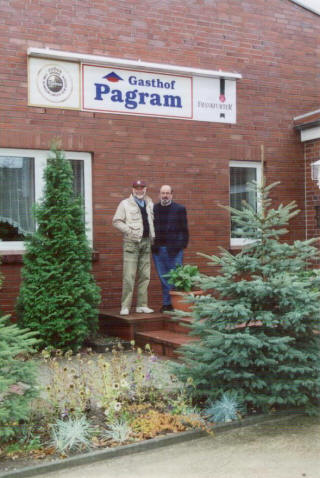HISTORICAL BACKGROUND OF THE PAGRAMS
If you consult "The Historical Research
Centre" a commercial organisation that provides data on family
names - this is what they say about the Pagrams:
I Quote:
" The English surname Pagram, and its
variants Pigram, Peagram, Pegrum, Peagrim, Peggram and Pilgrim,
is of nickname origin, that is, descriptive of some personal or
physical characteristic of the initial bearer. In this case, the
name is derived from the Old French "pelegrin', from the latin "peregrinum",
which in Middle English became "pilgrim, pelgrim", meaning
"pilgrim". This term was originally applied to a person who had
been on a pilgrimage to the Holy Land or to some seat of
devotion in Europe such as Santiago de Compostella or Rome, or
to one nearer home, for example the tomb of St. Thomas a Becket
at Canterbury. Such pilgrimages were often imposed as penances,
graver sins requiring more arduous journeys. Occasionally,
Pagram is also of patronymic origin, indicating " son of Pagram
or Pelegrin (pilgrim). The earliest record of this surname or a
variant dates back to 1185 when Hugo Pilegrim from Warwickshire
is mentioned in the "Records of the Templars in England in the
Twelfth Century". Hugo Peregrinus and Hago le pelerin are listed
as living in Suffolk between 1189-98. William Pegerim from
Dorsetis also recorded as William Pegrum in the "Curia Regis
Rolls" in 1200 and Eustace Pelrim was residing in Cambridgeshire
in 1221. The "Rotuli Hundredorum" of Cambridgeshire contains a
reference to one William Pegrim 1275 and Symon Pegrym is
mentioned in the "Subsidy Rolls" of Suffolk in 1327. The
marriage of Isaac Pegram and Martha Wyatt is registered in St.
George Hannover Square in 1785.
BLAZON OF ARMS: Azure, three pilgrims'
staves or. Translation: The pilgrims' staves are examples of
canting and act as puns on the origin of the surname. Azure
(blue) denotes Truth and Loyalty and or (gold) represents the
Sun and indicates Power and Splendour. Crest: An escallop or.
ORIGIN: England." Unquote.
There is now clear evidence that the
Pagrams in Australia were originally Pigrams. This happened
around 1820 when our Ancestor Thomas Pigram married Mary
Shildrick. When their children were born, they were recorded as
Pagrams. Thomas's parents were William and Elizabeth Pigram Born
1760, his Grandparents: Richard and Elizabeth Pigram Born
around 1708/1719 and his Great Grandparents : James and Sarah
around 1678/1680.
RICKLING ESSEX ENGLAND
In a direct line of succession, James
Pigram and Sarah Pigram (nee: Archer) bring this research to a
halt. However, there are records of Baptisms (31) , Marriages
(6) and Burials (19) at All Saints Church of England Rickling
for Pigrams dating back to 27th February, 1559 with the Baptism
of John Pigram.
James and Sarah Pigram were in Rickling
where all of their children were born : their first was James in
1699 and their last was Elizabeth in 1710. Rickling is located in
N/W Essex about 40 kilometres south of Cambridge. Its history
dates back to at least 1115 where there is a record of Beatrice
de Mandeville marrying Sir Hugh de Talbot. Hugh died and was
buried in Walden Abbey Rickling Essex 19 April 1197.
In 1870, the following description of
Rickling was recorded in the Imperial Gazetteer of England and
Wales: - "Rickling, a parish in Saffron/Walden District , Essex.
Near the river Stort and near the London and Cambridge Railway,
2 & half miles from the Newport Railway Station and 6 &
three/quarters N by E of Bishop Stortford.


ALL SAINTS CHURCH RICKLING
Did you know that there is a village of "Pagram"?
Yes there is. Surprisingly, it is not to be found in England. It
is located on the autobahn that runs from Berlin to Frankfurt am Oder
which is on the Polish border. Just ten kilometres back into
Germany from Frankfurt am Oder is Dorf Pagram. I have a German
friend who is a historian. He has an interesting theory about
the Pagrams. This is not proven, but plausible, and it makes a great
story. We have visited this Village. There are about 200
villagers. There is one Pub and two churches. The farmland is
mainly apple orchards. It's history goes back to the 1200"s. The
land was controlled by the Catholic church and ruled as a Bishopdom. The land then was used for sheep farming. Anyway,
this is my friend's theory. When the New World (North and South
America) was being developed there was massive migration of
peoples in Europe across the land mass to the ports with the
promise of a better life as a Settler in America. If you wanted
to migrate to the English colonies in Northern America, you
needed to get to the English Ports.
We are looking at the 16th Century. Many
people in Europe did not have formal surnames. So that a person
from the Village of Pagram would say that his name was, eg,
Jacob von Pagram (Jacob from Pagram). The von disappearing later
on. Now, Jacob made it to England but fell in love with an
English Beauty and settled in Essex. Thus the start of the
Pagrams. I think that this is just a nice fairy tale!
The photo on the left is Pam and me at the
entrance to the town. On the right is a photo of the only Pub.

